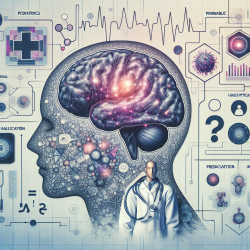Introduction
In the rapidly evolving field of healthcare, leveraging data to predict and manage diseases is becoming increasingly crucial. The study titled "Explainable Machine Learning for Predicting Conversion to Neurological Disease: Results from 52,939 Medical Records" provides a compelling case for using electronic medical records (EMR) to predict neurological diseases such as Alzheimer's, Parkinson's, Multiple Sclerosis, and Amyotrophic Lateral Sclerosis. This blog explores how practitioners can enhance their skills by integrating the outcomes of this research into their practice.
Understanding the Research
The study utilized a retrospective dataset from the Cleveland Clinic, focusing on patients diagnosed with various neurological diseases. By employing eXtreme Gradient Boosting (XGBoost), a powerful machine learning algorithm, the researchers developed individualized risk prediction models. These models were assessed for their transparency and fairness, providing a reliable tool for early diagnosis.
Key Findings
The study revealed that EMR data contains latent information that can be instrumental in risk stratification for neurological disorders. Key predictors included patient-reported outcomes, sleep assessments, falls data, additional disease diagnoses, and longitudinal changes in patient health, such as weight change.
- Alzheimer’s disease models achieved AUCs of 0.794, 0.742, 0.709, and 0.645 at 0, 12, 24, and 60 months prior to diagnosis, respectively.
- Amyotrophic lateral sclerosis models had AUCs of 0.883, 0.710, 0.658, and 0.620.
- Multiple sclerosis models showed AUCs of 0.922, 0.877, 0.849, and 0.781.
- Parkinson’s disease models reached AUCs of 0.809, 0.738, 0.700, and 0.651.
Implications for Practitioners
For practitioners, integrating these findings into practice can significantly enhance patient outcomes. Here are some steps to consider:
- Incorporate EMR Data: Utilize EMR data to identify early signs of neurological diseases. This proactive approach can facilitate timely interventions.
- Focus on Key Predictors: Pay attention to patient-reported outcomes, sleep patterns, and weight changes as they are significant predictors of neurological diseases.
- Adopt Explainable AI Tools: Use tools that provide transparency and allow for a better understanding of predictions, enabling personalized patient care.
- Engage in Continuous Learning: Stay updated with the latest research and advancements in machine learning applications in healthcare.
Encouraging Further Research
While this study provides a robust framework for using EMR data in disease prediction, further research is necessary to enhance model accuracy and applicability across different populations. Practitioners are encouraged to participate in research initiatives and contribute to the growing body of knowledge in this field.
Conclusion
Incorporating explainable machine learning models into clinical practice can revolutionize how neurological diseases are predicted and managed. By focusing on data-driven decisions, practitioners can significantly improve patient outcomes and contribute to the advancement of healthcare. To delve deeper into the research, read the original paper: Explainable machine learning for predicting conversion to neurological disease: Results from 52,939 medical records.










